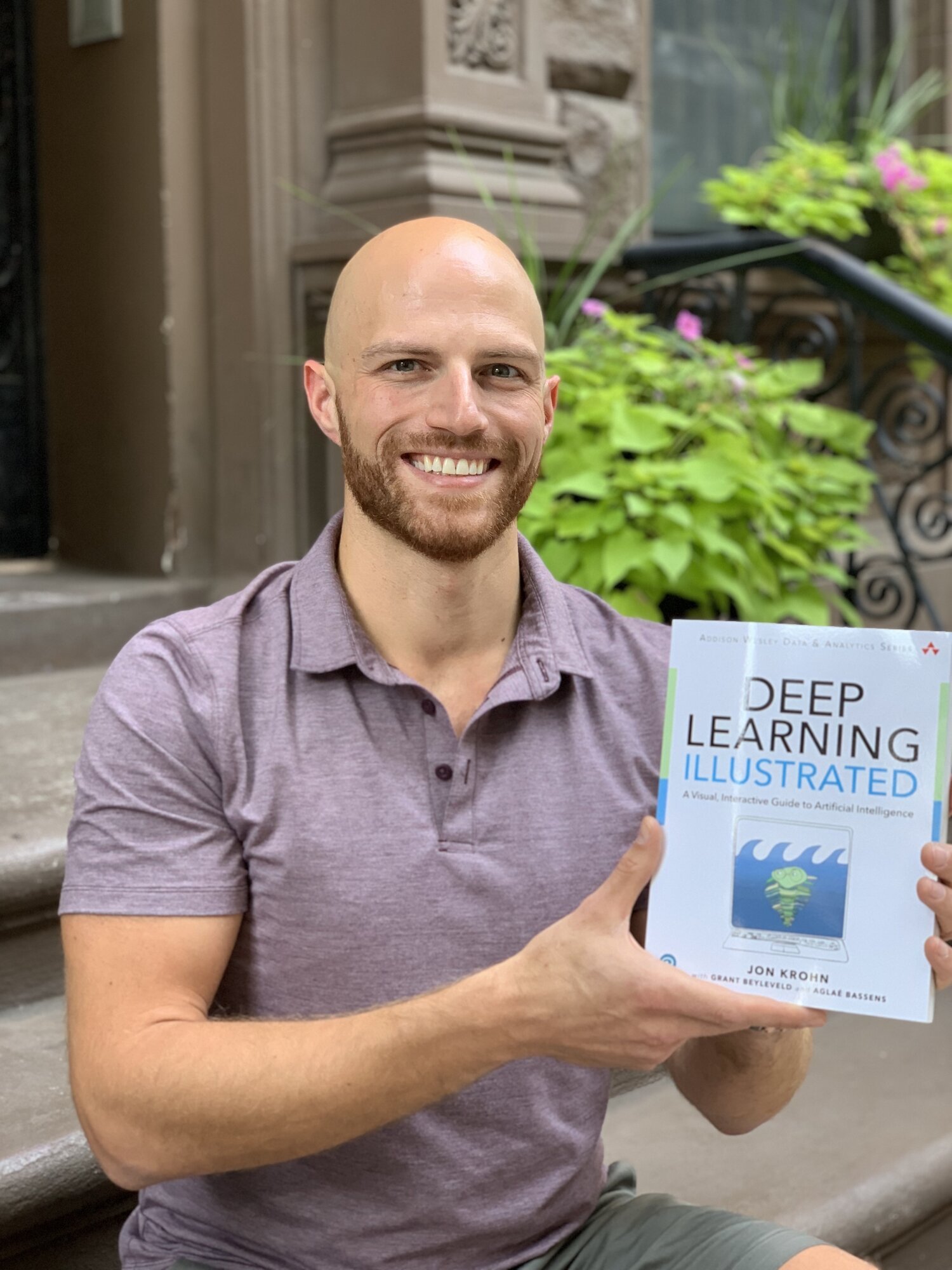Research and Publications
My expertise is the development and application of machine learning techniques — particularly deep neural networks for processing natural language — to make predictions with large, high-dimensional data sets.
The results of my academic analyses in the fields of genetics and neuroscience have contributed to a better understanding of a wide range of natural phenomena, including multiple sclerosis, cholesterol levels, morphology, nausea, fear, sleep, visual perception, neuroanatomy, gene expression, and the interaction of genetics with life experience.
In industry, I’ve applied machine learning toward the automation of processes across financial markets, digital advertising platforms, and the field of human resources.
Book
Krohn, with Beyleveld & Bassens. (2020). Deep Learning Illustrated. Addison-Wesley
Books from “Jon Krohn’s Pearson AI Signature Series”
Ozdemir. (2026). Building Agentic AI. Addison-Wesley
St Lawrence (2026). Becoming An AI Orchestrator. Addison-Wesley
Key Peer-Reviewed Papers
Baud, Mulligan, Casale, et al. (2017). Genetic variation in the social environment contributes to health and disease. PLOS Genetics 13: e1006498 [covered by BBC, Sun, Daily Mail, Live Science, Le Temps, and 30 other media outlets, earning finalist recognition for a PLOS Genetics Research Prize in 2018]
Krohn, Rives-Corbett, & Donner. (2016). Predicting Job Application Success with Two-Stage, Bayesian Modeling of Features Extracted from Candidate-Role Pairs. In Proceedings of the Joint Statistical Meetings, Section for Statistical Learning and Data Science: 3667-71
Agakov, McKeigue, Krohn, & Storkey. (2010). Sparse Instrumental Variables (SPIV) for genome-wide studies. Advances in Neural Information Processing Systems 23
Extended-Length Video Tutorials
Krohn. (2021). Data Structures, Algorithms, and Machine Learning Optimization. Addison-Wesley
Krohn. (2021). Probability and Statistics for Machine Learning. Addison-Wesley
Krohn. (2021). Calculus for Machine Learning. Addison-Wesley
Krohn. (2021). Linear Algebra for Machine Learning. Addison-Wesley
Krohn. (2021). Mathematical Foundations of Machine Learning. Ligency
Krohn. (2020). Machine Vision, GANs, and Deep Reinforcement Learning. Addison-Wesley
Krohn. (2020). Deep Learning for Natural Language Processing, 2nd edition. Addison-Wesley
Krohn. (2020). Deep Learning with TensorFlow, Keras, and PyTorch. Addison-Wesley
Krohn. (2018). Deep Reinforcement Learning and Generative Adversarial Networks. Addison-Wesley
Krohn. (2017). Deep Learning for Natural Language Processing. Addison-Wesley
Krohn. (2017). Deep Learning with TensorFlow. Addison-Wesley
Additional Peer-Reviewed Papers
Robinson, Kleinman, Graff, et al. (2017). Genetic evidence of assortative mating in humans. Nature Human Behaviour 1: 16
Davies, Brown, Cais, et al. (2017). A point mutation in the ion conduction pore of AMPA receptor GRIA3 causes perturbed sleep patterns as well as intellectual disability. Human Molecular Genetics 26: 3869-82
Taylor, Martin, Lise, et al. (2015). Factors influencing success of clinical genome sequencing across a broad spectrum of disorders. Nature Genetics 47: 717-26
Krohn, Speed, Palme, et al. (2014). Genetic interactions with sex make a relatively small contribution to the heritability of complex traits in mice. PLOS ONE 9: e96450
Randall, Winkler, Kutalik, et al. (2013). Sex-stratified genome-wide association studies in 270,000 individuals show evidence for sexual dimorphism in genetic loci for anthropometric traits. PLOS Genetics 9: e1003500
Agakov, Krohn, Colombo, McKeigue (2011). Sparse instrumental variables: an integrative approach to biomarker validation. Journal of Epidemiology and Community Health 65: A10
Chen, Krohn, Bhattacharya, Davies (2011). A comparison of exogenous promoter activity at the ROSA26 locus using a PhiC31 integrase mediated cassette exchange approach in mouse ES cells. PLOS ONE 6: e23376
Agakov, McKeigue, Krohn, Flint (2011). Inference of causal relationships between biomarkers and outcomes in high dimensions. Journal of Systemics, Cybernetics and Informatics 9: 1-8
Orton, Wald, Confavreux, et al. (2011). Association of UV radiation with multiple sclerosis prevalence and sex ratio in France. Neurology 76: 425-31
Limebeer, Krohn, Cross-Mellor, et al. (2008). Exposure to a context previously associated with nausea elicits conditioned gaping in rats: A model of anticipatory nausea. Behavioural Brain Research 187: 33-40
Doctoral dissertation, on statistical and machine learning approaches for uncovering the genetic bases of behaviour, is available via the Oxford University Research Archive.
Served as Technical Reviewer
Nield (2022). Essential Math for Data Science. O’Reilly
Kienzler & Nilmeier (2020). What’s New in TensorFlow 2. O’Reilly
Ameisen (2020). Building Machine Learning Powered Applications. O’Reilly
Graesser & Keng (2019). Foundations of Deep Reinforcement Learning. Addison-Wesley
Géron (2019). Hands-On Machine Learning with Scikit-Learn, Keras, and TensorFlow (2nd ed.). O’Reilly
Li & Qiu (2019). Reinforcement Learning for Cyber-Physical Systems: with Cybersecurity Case Studies. Chapman and Hall


